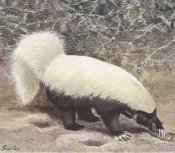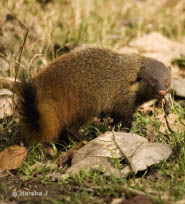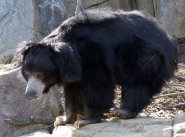Thursday 28 May 2009
Madras Tree Shrew

The
Madras Treeshrew (
Anathana ellioti), also known as the Indian Treeshrew, is a small mammal that lives in the hilly forests of southern India. It is related to the other treeshrews; however it is in a different Family, and is monotypic (only one kind). The Madras Treeshrew is omnivorous, and has the same kind of unspecified molars as the other Treeshrews in the order
Scandentia. They resemble most other treeshrews, however have larger ears, and also are speckled brown, yellow or black over their fur. The main body of fur usually has a reddish tinge and the ventral area is white most of the time - although all these colorations will vary from individual to individual. They are usually 16-18 centimeters in length (6-7 inches) and the tail is usually that same length making the total length about 32-36 (13-17 inches long). On average they will weigh about 160 grams (5 and a half ounces) although larger specimens have been recorded.
The habitat of the Madras Treeshrew is that of a partially moist to very moist forest habitat, with deciduous trees and shrubs making up the forest floor. However, they can also be found in the southern India slopes, and ravines, along with cultivated fields or pastures. They have proven to adapt to surrounding if the conditions are right and feast on the abundance of insect life in their chosen areas. They eat caterpillars, ants, butterflies, moths, and anything else that will satisfy - they also eat berries and seeds, and have been known to eat the fruit of the Lantana Camara, a very thorny but common shrub.
Although the Madras Treeshrew has the word tree in its name, it is in fact uncommon to see one climb a tree, and when they do climb a tree it is usually a means of escape, or of play with younger Treeshrews, and maybe the rare exception of a safe place to self-groom - and to do this they will climb the tree, and then slide down it stretched out. They will repeat this at every angle until they feel sufficiently groomed. The majority of time is spent hidden on the forest floors, travelling specially made ‘roads’ under the brush, and inspecting their territories or looking for some insects or seeds to eat.
Madras Treeshrews also like to build night shelters between soft ground and stones, which can be very complex or very simple. They rarely house more than one, as the treeshrew in general is a solitary species, with the Madras Treeshrew being one that is paired only during certain times of the year if at all. The behavior in regards to mating is not well known, however due to studies of their biology it is assumed that they can produce up to five young at a time. If they are at all similar to other treeshrews they may only spend a short time with their young, and their young will mature rapidly, leaving the nest in three to five months.
A few facts about the Madras Treeshrews
- The Madras Treeshrew can be seen as similar to the squirrel, however a difference is that the treeshrew will walk with its tail in an upward curve and a curl that continues that - unlike the squirrel who’s tail does start going up, but curls the opposite direction.
- The name Anathana ellioti in which Anathana is the genus comes from the Tamil words Moongil Anathaan, which has the meaning of ‘Bamboo Squirrel’ while ellioti, the species name, comes from the man who first documented the species - Sir Walter Elliot.
- The Madras Treeshrew mostly forages in the morning, rather than the evening, as an advantage over other foragers who start later in the day.
Picture of the Madras tree shrew was photographed by S. Karthikeyan in Yercaud, India, licensed under
GFDL
You can help spreading the word about this animal by liking it on facebook
Permanent Link
Monday 18 May 2009
Western Hog-nosed Skunk
 Length
Length: 55-60 cm (22-24 inch)
Weight: 1.9 kg (4.18 lbs)
The
Common Hog-nosed skunk (
Conepatus mesoleucus) or Western Hog-nosed skunk or Rooter skunk can be found in the southwestern United States (Arizona, New Mexico, Texas) and through Mexico to Nicaragua. The Common Hog-nosed skunk forages in a special way, it plows through the soil and leaves a 'plowed through' area. Common Hog-nosed skunks search for food with their noses. Their diet mainly consists of grubs and worms, which they catch using their both claws and their nose.
Ordinarily, one would be very focused when it is busy with a specific task, and as a result, it would not notice a predator at its back. The strongest facet of the defense system of the Common Hog-nosed skunk is its musk, which is very repelling. So much so that it has been studied that even rattlesnakes get repelled by the smell.
This skunk prefers grounds which are sparsely vegetated and at the same time, filled with rocks. They often construct dens from crevices of boulders or other forms of shielded places.
The fur of this skunk is rough, with a brown coloring over a dark brown layer. Big white stripe goes along the body, it has a long snout, and both front and hind feet possess five digits. However, their front feet, which are used for digging, are better constructed than the hind ones.
When in captivity, these skunks are alleged to be docile enough to be kept as a pet (if you can stand the smell !).
Interesting fact: It is possible to touch newborns, even in the presence of the mother, assuming the parent trusts that particular person.
You can help spreading the word about this animal by liking it on facebook
Permanent Link
Monday 11 May 2009
Striped-necked mongoose
 Body length
Body length: 43-53 cm (17 - 21 inch)
Tail length: 40 cm (16 inch)
Weight: 1.36-2.73 kg (3-6 lbs)
The
Striped-necked mongoose (
Herpestes vitticollis) is the biggest Asian mongoose and is confined to Sri Lanka and India. On Sri Lanka, they can be sighted at the well-wooded habitats, particularly in the dry and moist deciduous forests where they prefer streams and rivers. Striped-necked mongooses have short limbs, with long fore-claws and the color of their fur can be dark brown, gray-yellow, or orange-yellow. The male weighs at around 3.1kgs and the females would weight much less.
A litter of the Striped-necked mongoose ranges from 2 to 3, and the newborns hunt with the parent until they are independent. This mongoose is frequently sighted in daytime at the open sea, and more often than not, it is solitary. Their diet consists mainly on crabs, as well as birds, small mammals (such as mouse deer), fish, frogs, grubs, insects and certain kinds of roots.
There are types of mongoose that are comfortable living near human settlements, but this specific mongoose is not one of them. They prefer to stay within a forest, and near a body of water.
Actually, two subspecies are recognized in India, these are:
Herpestes vitticollis vitticollis, which can be distinguished by the chestnut-red color of the coat. The second is the
Herpestes vitticollis inornatus, which has no red marking/color.
Interesting fact The Striped-necked mongoose could also prey on something bigger than himself, for example the Indian hare.
You can help spreading the word about this animal by liking it on facebook
Permanent Link
Tuesday 05 May 2009
Sloth Bear - the noisy vacuum cleaner

The
Sloth bear (
Melursus ursinus) has a shaggy, black pelage, long claws which they use for gathering termites/ants. At the chest area, we could see a Y-shaped mark, sometimes it is V-shaped. The Sloth Bear's nostrils could close, and they do this to protect themselves from the dust, or from the insects when they are turning a beehive into lunch. Another facet of this bear: they have a gap in the teeth to allow them to suck up termites or ants.
Sloth Bears, majority of them anyway, are in Sri Lanka and India, but some are living in parts of Nepal. Under the "World Conservation Union's Red List of Threatened Animals", these bears are now "vulnerable", and it could turn into "highly endangered" sooner than later.
A Sloth bear is capable of living in both wet and dry forests, but grasslands are also part of their preferred habitat.
Besides the ants and the termites, the Sloth bear could also go for figs, mangoes, ebony, and some variety of flowers, but the termites and the ants serve as the main constant food source. Other things they eat ar honeycombs, grubs and beetles.
These bears are nocturnal and is rather noisy. It snorts and grunts when it grabs at branches. It also uses its lips in a vacuum-like manner, and I mean a vacuum cleaner. Imagine the noise of an old-and-about-to-be-retired vacuum cleaner and you'll get the idea.
Interesting fact: In zoos, the bears can become up to forty years of age...
Picture of the sloth bear by Aaron Siirila, licensed under
Creative Commons Attribution ShareAlike License v. 2.5
You can help spreading the word about this animal by liking it on facebook
Permanent Link
 The Madras Treeshrew (Anathana ellioti), also known as the Indian Treeshrew, is a small mammal that lives in the hilly forests of southern India. It is related to the other treeshrews; however it is in a different Family, and is monotypic (only one kind). The Madras Treeshrew is omnivorous, and has the same kind of unspecified molars as the other Treeshrews in the order Scandentia. They resemble most other treeshrews, however have larger ears, and also are speckled brown, yellow or black over their fur. The main body of fur usually has a reddish tinge and the ventral area is white most of the time - although all these colorations will vary from individual to individual. They are usually 16-18 centimeters in length (6-7 inches) and the tail is usually that same length making the total length about 32-36 (13-17 inches long). On average they will weigh about 160 grams (5 and a half ounces) although larger specimens have been recorded.
The Madras Treeshrew (Anathana ellioti), also known as the Indian Treeshrew, is a small mammal that lives in the hilly forests of southern India. It is related to the other treeshrews; however it is in a different Family, and is monotypic (only one kind). The Madras Treeshrew is omnivorous, and has the same kind of unspecified molars as the other Treeshrews in the order Scandentia. They resemble most other treeshrews, however have larger ears, and also are speckled brown, yellow or black over their fur. The main body of fur usually has a reddish tinge and the ventral area is white most of the time - although all these colorations will vary from individual to individual. They are usually 16-18 centimeters in length (6-7 inches) and the tail is usually that same length making the total length about 32-36 (13-17 inches long). On average they will weigh about 160 grams (5 and a half ounces) although larger specimens have been recorded. 
 Length: 55-60 cm (22-24 inch)
Length: 55-60 cm (22-24 inch) Body length: 43-53 cm (17 - 21 inch)
Body length: 43-53 cm (17 - 21 inch) The
The